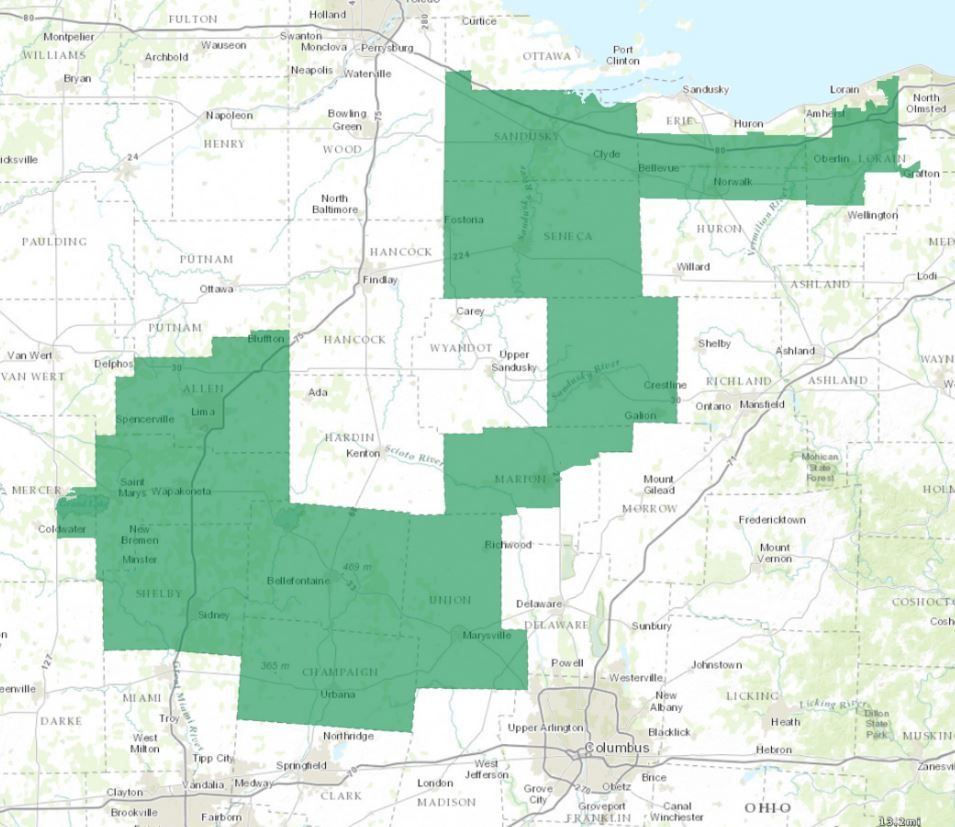*Read all of David's writing and watch his fantastic videos at Pepperspectives!
By David Pepper
Believe it or not, among the biggest contributors to the Ohio GOP and politicians like Mike DeWine are….Ohioans struggling to make ends meet.
We’re talking HUGE contributors—collectively, at least.
Year after year.
But there’s a catch…
Most have no clue their own dollars are playing such a big role in Ohio politics. Still, struggling Ohioans have been bankrolling the campaigns of powerful Ohio politicians for years.
How?
Because as I describe in Laboratories of Autocracy, one of the biggest instances of pay to play in Ohio involves who gets to do debt collection work for the Ohio Attorney General.
And due to blatant pay to play, everyday Ohioans’ dollars end up in the hands of Ohio politicians through a simple waterfall scheme:
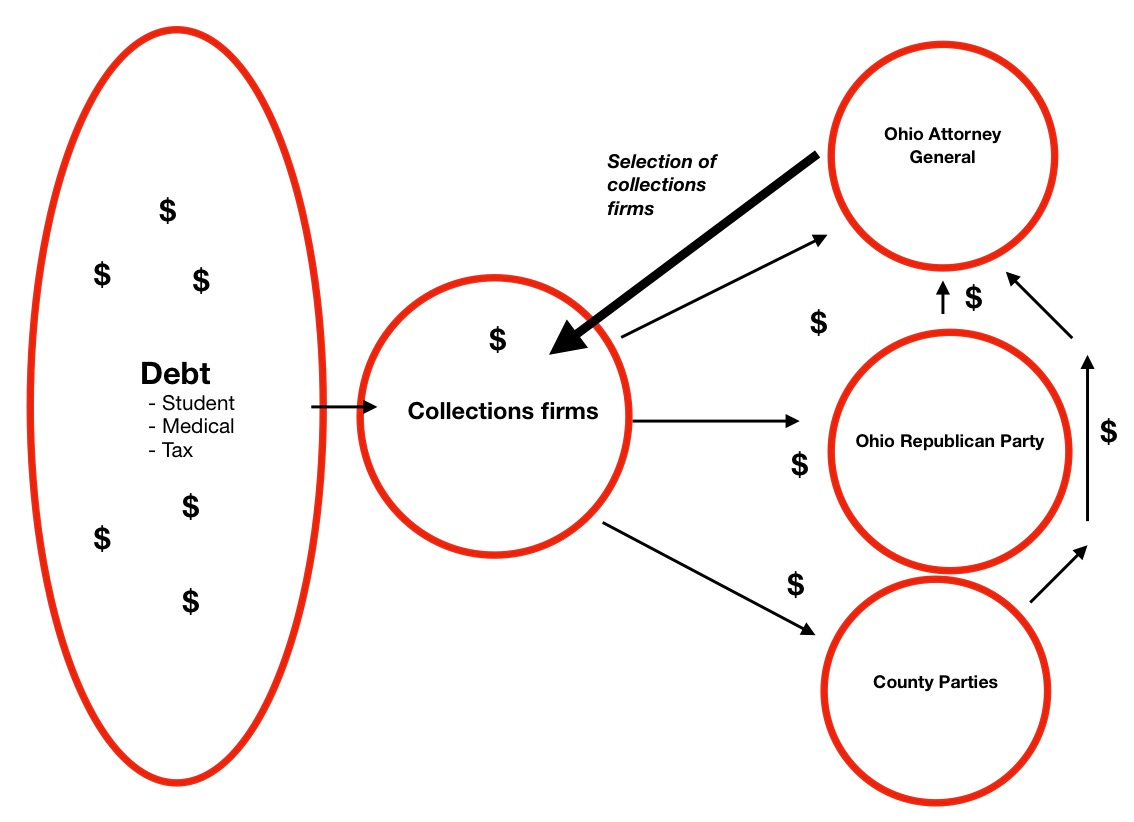
In this way, small streams of dollars from thousands of individual Ohioans’ debt payments flow together into a flood of riches for both the collectors and the politicians —totaling millions of dollars in donations, year after year. Lobbyists also have found a way to profit from this river of money, now routinely hired by the collectors as middle men to ensure that the work from the Attorney Generals’ office keeps coming their clients’ way. (One such lobbyist, an old friend of Mike DeWine, now sits on the Ohio State Board of Trustees).
So that’s how Ohioans who are paying off college debt and medical debt and tax debt (struggling to the point where they are in collections) are forking over some portion of their debt to politicians, via the collections process.
It’s like a tithe, but one they don’t know they’re paying. Let alone know what their tithe is paying for--attack ads on TV, digital ads, salaries of staff, you name it.
When I first saw this for what it is, I was horrified. And still am. What a twisted system!
But then I looked around.
And I found that this reality—that the hard-earned dollars of everyday Ohioans are the major source of political dollars and power for Ohio politicians—is everywhere. The same essential pattern takes place in so many different ways. It looks like this:\
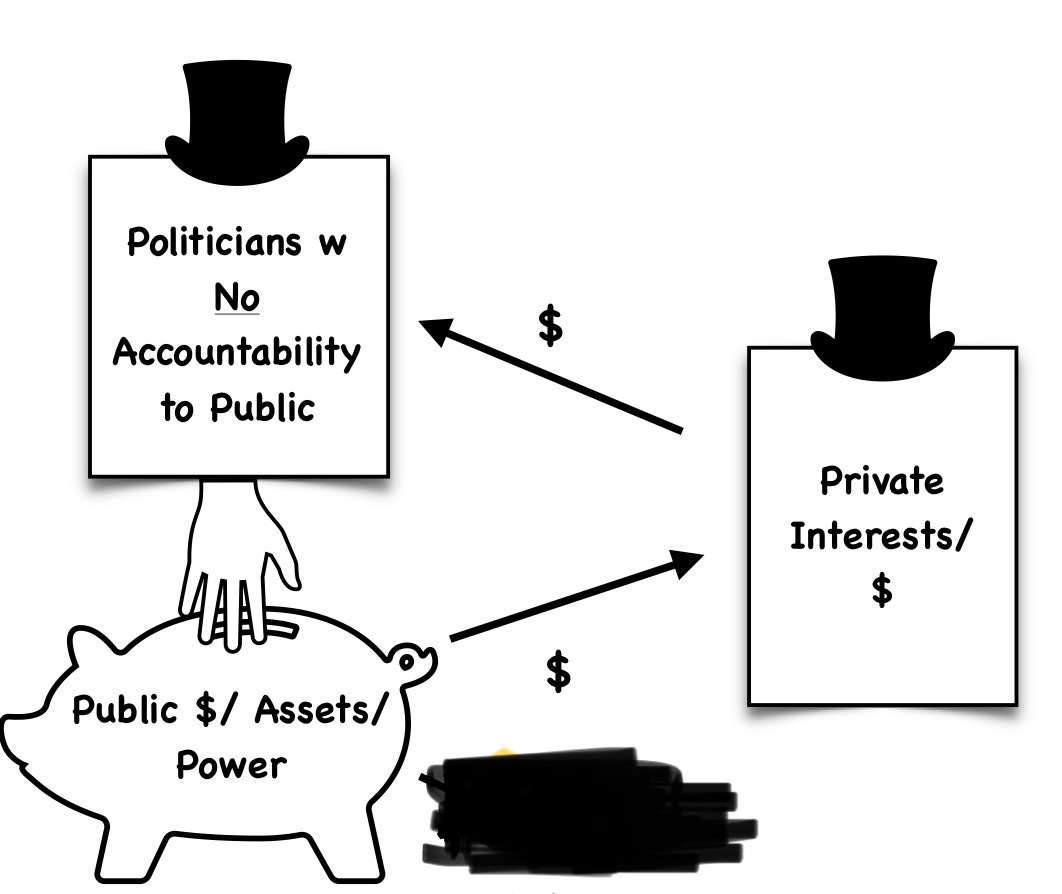
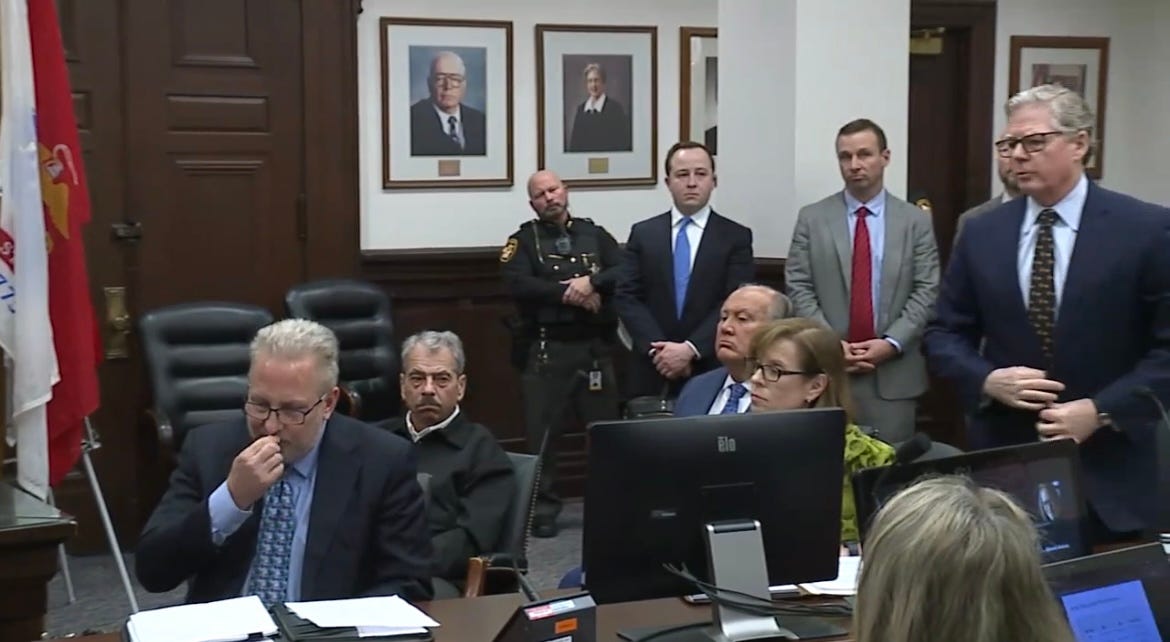
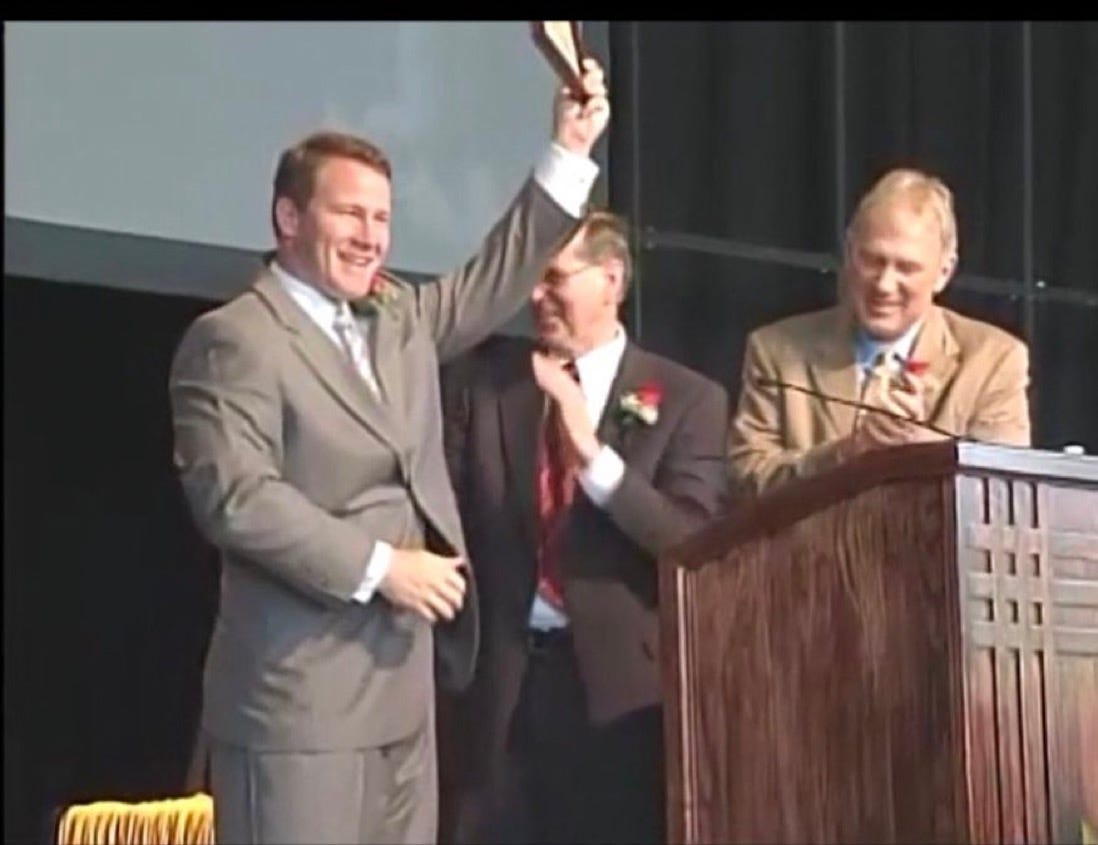

See the picture now?
The funds that fuel so much of the power and, yes, corruption and broken politics of states like Ohio (sadly, this is the pattern way beyond Ohio) may seem like they come from the most wealthy and well-connected people in these states.
That’s often the impression that’s left, isn’t it?
But the truth is, those funds usually come from the people themselves. And the bigger the scandal, it seems, the more likely that is to be the case. Because huge numbers of everyday Americans, each pitching in some funds, are what lead to the enormous sums of money that some at the top are so eager to get their hands on.
All of this shows you how public corruption really works in states like Ohio.
Like that debt collection model, it’s basically politicians and other entities positioning themselves amid that ocean of public money so that they can direct where some of those funds can flow. Of course, getting elected is what gives the politicians the initial power to direct these funds. But taking steps such as removing transparency, checks and balances, bidding processes, and independent oversight also are key tools that facilitate it all (such as getting rid of the independent state school board, the separate oversight of charter schools that once existed, or eliminating the meaningful regulation of utilities).
Once there, politicians diverting even a small (percentage-wise) stream of that ocean of public funds to private players—or in a direction that private players want them to—can mean millions, tens of millions or billions for those private players.
And when even a portion of those diverted funds are then converted back into contributions to those politicians, you’re talking hundreds of thousands or millions more for the politicians.
So that’s your basic pay to play model—resulting in everyday Americans directly or indirectly funding politicians and their campaigns. (Yes, it’s ironic that many of these politicians oppose public financing of campaigns when many of them are essentially publicly funded in the way I just described).
Now widen the lens just a little bit, and think of other public assets as well. Assets with value.
Public parks—now being tapped into in Ohio for fracking.
Other public funds—now being diverted to support private schools in the hundreds of millions, or even billions.
Other forms of public power (regulations)—being put to work for private interests, and not the public. Example: the Governor and Lt Governor of Ohio pushing the consultant hand-picked by First Energy to oversee the utility commission that regulates…First Energy.
It’s all the same model. Politicians putting public assets to work for private interests.
While you pay for it all.
So when I talk about corruption in states, I’m not just talking about the fact that occasionally, politicians go even further than all this and decide to use some of these funds for their personal gain (beyond their campaign accounts). Needless to say, that takes the corruption to an even higher level. It also puts an especially juicy target on the back of whoever does that, and makes it far easier to prosecute, which is why these are often the only cases we hear about.
As bad as these crimes are, my concern is actually far broader than those cases.
Because the true rot—and by far the most damage—comes even before such personal bribes or graft are involved, or even if they never are involved at all. It comes from the broader corruption taking place—the corruption of public service itself, where public funds and assets and powers are put to work for private players (including the inevitable transfer of some dollars back to the politicians) as opposed to supporting the public interest and common good.
That’s the corruption that truly robs the public of the benefit and positive outcomes that are supposed to come from their dollars:
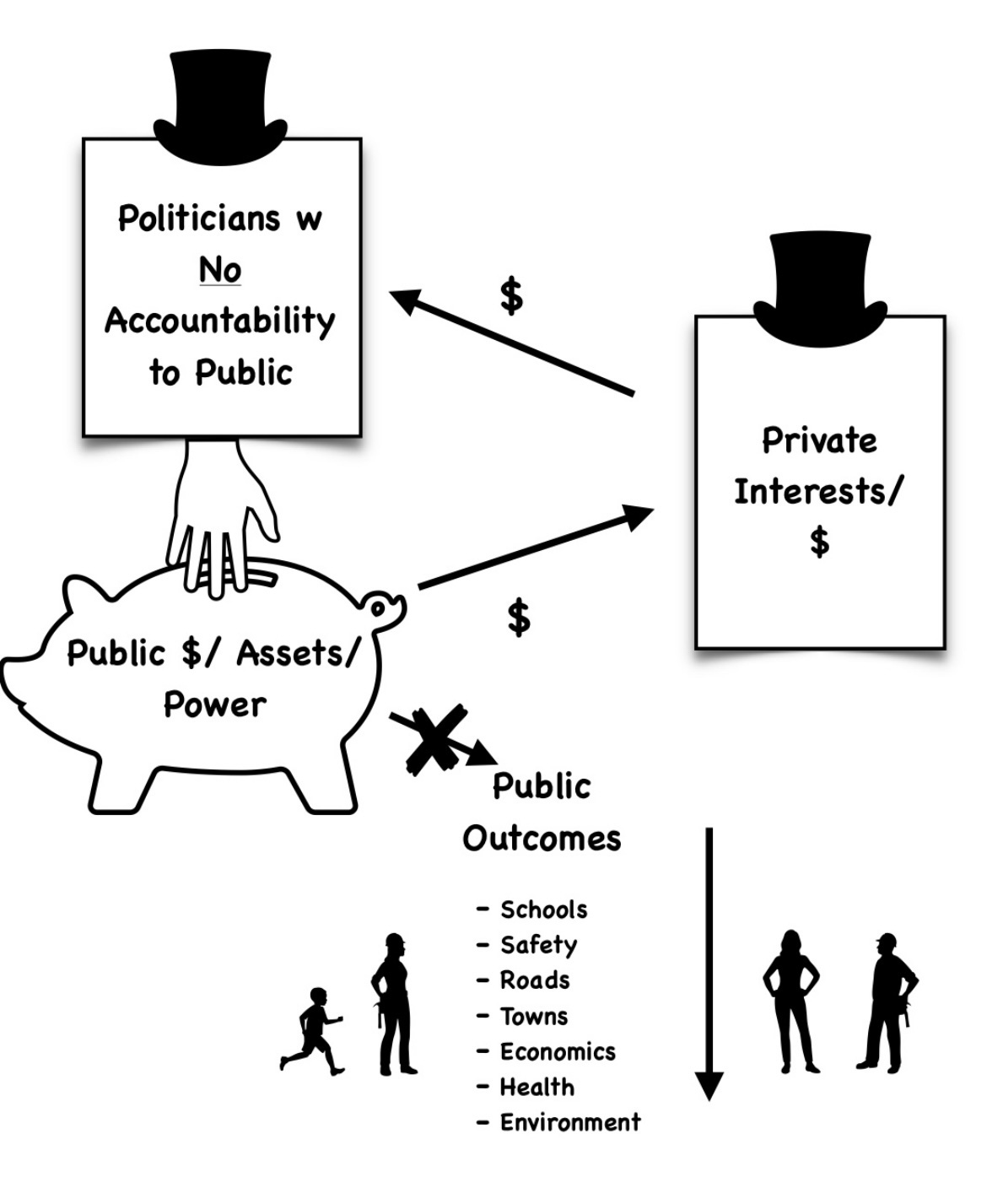
So, people may ask: If politicians are diverting public funds and powers to these private ends, why don’t the people stand up and vote those politicians out?
First, so much of these details are taking place below the public radar. People may know corruption is out there, but they too rarely see that their own money is fueling so much of it.
Second, the amount of dollars flowing to politicians through these various pay-to-play schemes is enormous—giving them a huge advantage in campaigns for as long as they keep diverting those funds to those who kick some of it back. (Trust me, I lived that first-hand when I ran for Attorney General; every filing, you can see all that pay-to-play money flow into the incumbent’s campaign account).
Third, this is where gerrymandering comes in.
The rigging of districts plays a key role in locking this corruption into place. Because even though everyday people’s funds are being diverted in all the ways I outlined above, gerrymandering cuts off the people’s opportunity to hold accountable those doing the diverting.
The people may be paying the higher energy bills, the school taxes, the debt, the pension contributions. And all that money may fuel everything else—providing the source of so much power for the politicians.
But just like DeWine negated the votes of those retired teachers, gerrymandering systematically does the same thing to everyday Americans. It keeps most from being able to protect their public dollars by casting meaningful votes—at least at the state legislative level. (And the state legislative level is where a large number of these decisions are being made).
So your money’s all in, but your power as a voter is often completely cut off from the decisionmaking about your money.

One other maddening irony: if you watch closely, the very politicians who accumulate campaign dollars and power by giving away these public funds often show little to no respect for the very people paying those funds.
DeWine’s negating of the votes of those teacher retirees is a perfect example.
But it goes much further than that.
Think about the disrespect and the non-stop attacks on public school teachers in this country. Pilloried. Defamed as so-called “groomers” by the right. Accused of indoctrinating kids. Their efforts to demand better wages and stronger schools through collective bargaining, dismissed with the most union-bashing language. The very schools they work for being undermined by the explosion of vouchers propping up private schools. Teaching has become such a tough profession due to all this and more.
Yet the money those teachers build through their pension contributions is so important—of such value—that a Governor looks to have broken the law to assert more control over it.
If only teachers’ themselves were valued as much by political bigwigs as the sum total of their pension contributions.
And what about those struggling Ohioans who are paying all that debt? How do the politicians in power treat them—the original source of so much money that lands in party and candidate accounts?
Let’s look at college debt in particular.
Due to budgeting decisions, Ohio is one of the worst states when it comes to college affordability, which also means it is one of the worst-ranked states in the country when it comes to student debt owed by young Ohioans. Already shabby treatment.
And what happened when Joe Biden tried to help young Ohioans caught in this uniquely deep debt trap? Ohio’s Attorney General (Yost), whose campaign account receives a big chunk of funds from all that debt through the waterfall I described above, filed a brief with the United States Supreme Court to halt that debt relief effort.
You’d think he’d treat his donors better than that! Then again, if all that debt were to disappear, there would be less to collect, and therefore….
Bottom line: there is a systematic corruption of public service itself in states across the country. Lack of accountability back to everyday Americans is sustaining it even as it delivers poor results for those footing the bill.
If we are not pushing policies and politics that address this corruption at its core, we will keep seeing the same meager and twisted results.
And yes, we will keep paying for all of it—including unwittingly funding the campaigns of the very people who keep it all going.
